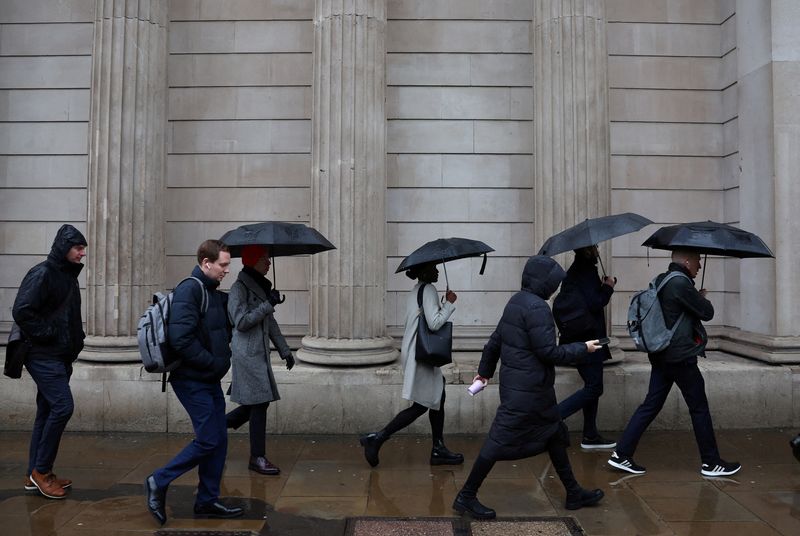By Sinead Cruise and Carolyn Cohn
LONDON (Reuters) - Some of Britain's top financial firms pay women 28.8% less on average than male counterparts, salary data from 21 companies reviewed by Reuters shows, even though they say they are striving to hire more females for higher-paid, senior roles.
Banks, asset managers and insurers across the UK have committed to narrowing long-standing gender pay gaps, which they largely attribute to there being more men in top jobs that come with generous bonuses, while a greater proportion of women are in lower-paid, part-time or junior jobs, with smaller bonuses or none at all.
The gap for the top financial services firms has narrowed by two percentage points from a year ago, according to Reuters calculations based on the salary data, but remains far higher than the mean average for all industries in Britain which was 10.7% last year, based on a UK government survey.
Since 2017 businesses with more than 250 employees in Britain have been required to disclose the difference between the pay and bonuses of male and female staff. They had a deadline of April 4 to disclose data for April 2023.
Many of the big finance companies struggle to attract and retain female talent in high-powered roles, hampering the rate of change across the industry and in some individual cases the situation has not improved.
At Goldman Sachs' international division in London the mean pay gap between men and women rose to 54% in 2023 from 53.2% the prior year and remains the largest among the 21 major finance employers whose data was reviewed by Reuters.
“Importantly, this gender pay gap report does not account for pay in similar role or tenure, but we know that we need to do more to increase representation of women at the senior-most levels of the firm,” a spokesperson for Goldman said.
Insurer Admiral reported a mean pay gap of 13.5% in 2023, the smallest gap of the data reviewed.
SLOW PROGRESS
The slow pace of progress has prompted questions as to why the gap is not shrinking more quickly.
"Finance sector employers need to ask themselves some hard questions about why women are not reaching their top ranks - and earning the pay that goes with those jobs," Ann Francke, CEO of the Chartered Management Institute, told Reuters.
HSBC disclosed a mean pay gap of 43.2% in 2023, across all its UK entities. In 2022, it reported a 45.2% mean average gap between female and male earnings.
More than half the bank's staff are female, 62% of which are in junior roles, HSBC said. Just under a third of its senior leadership team were women at April 5, 2023, up 1.4 percentage points on 2022.
The mean pay gap across Morgan Stanley's UK workforce narrowed to 40.1% from 40.8%, while Barclays closed its mean pay gap by 2.3 percentage points to 33.6% in 2023.
JP Morgan disclosed a 1.5 percentage point fall in its mean pay gap to 26.1%. The U.S. bank said representation of women in senior UK roles stood at 29.5% as of February 2024, its highest level since 2018.
Standard Chartered (OTC:SCBFF)'s mean pay gap narrowed the most percentage points across the banks reviewed by Reuters, to 22% in 2023 from 29% the year prior.
The Asia-focused bank reported a positive trend in women taking leadership roles, up from 25% in December 2016 to 32.5% at end-December 2023.
Among insurers and asset managers, Aviva (LON:AV) said its mean pay gap dropped to 21.3% in 2023, from 24.3% the year prior. Abrdn disclosed a 3.9 percentage point narrowing to 24.8% in 2023. But Legal & General said its pay gap widened, coming in at 21.3% in 2023 from 20.9% the year prior.
'CHILD PENALTIES'
All companies said in their gender pay gap reports that differences reflected the under-representation of women in senior roles and that they were taking steps to address this.
The UK government launched the HM Treasury Women in Finance Charter in March 2016 to encourage the financial services industry to improve gender balance in senior ranks.
The charter now has more than 400 signatories covering about 1.3 million employees.
An annual review published last month with think tank New Financial showed that the signatories had increased female representation in senior ranks to 35% on average in 2023, from 34% in 2022.
At this pace, the average of those who signed up to the Charter should reach parity in 2038 but not in every sector, the report said.
Analysis by the Institute for Fiscal Studies (IFS) suggests that most UK gender pay gaps reflect "child penalties", with female average earnings falling sharply after becoming a parent.
The IFS found that seven years after the birth of a first child, women's earnings were on average less than half of men's.
The CMI's Francke said all industries needed to face bigger consequences of slow or erratic progress in tackling pay inequity, such as fines, restricted access to government or public sector work or "naming-and-shaming".
"The evidence tells us firms that represent the wider population - at every level including the top table - make better decisions and deliver better results," said Francke.

"That alone should be motivation enough to prompt the changes we need to see to close the gender pay gap."
Reuters also reviewed gender pay data for Bank of America, Citi, Deutsche, Lloyds (LON:LLOY), Nationwide, NatWest Bank, UBS, M&G, Phoenix, Schroder Investment Management and St James's Place.
